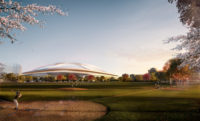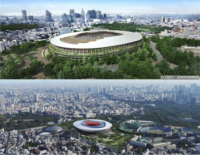Kiev, Ukraine
The tumult of Kiev's postwar history is evident in its architecture: The bombast of Stalin's elephantine classicism was abruptly superseded by swaths of grimly utilitarian housing after Khrushchev's turn against “unnecessary excess.” Following the disintegration of the U.S.S.R., speculative developers in the Ukrainian capital reacted to these drab slabs with crass Postmodernism. The pendulum may have swung again with the $380 million renovation of the city's Olympic Stadium. Its design, by the German architectural firm von Gerkan, Marg und Partner (GMP), harks back to what project director Christian Hoffmann sees as the better qualities of Kiev's 1960s rationalist architecture: technical ingenuity and tectonic clarity.
The stadium was renovated to host a major soccer tournament, Euro 2012—seen as an important way of improving Ukraine's image. However, the building's role as a national symbol is balanced against its responsibilities as a piece of the city. “We have designed stadia elsewhere that are more spectacular,” says Hoffmann, “but here we are in the middle of the city and didn't want to be so 'noisy.' ”
The open-air Olympic Stadium, named for its supporting role in the 1980 Moscow Games, developed in stages. The lower tier was built in 1936 against a hillside. The east stand cut into the slope; to the west, terraces bridged the gap between the bowl and the ground. A prestressed-concrete upper tier was added in 1968. Its delicate waffle slab and sharply angled beams balance on a single row of columns around the lip of the lower bowl. Although this elegant structure could not take the load of a roof, GMP wanted to retain the upper bowl “out of respect for the intelligence and the aesthetic sense of its engineers,” says Hoffmann. Kievans also identified strongly with the building, “so we weren't forced to bring something new. Instead we saved it, and tried to show it in a good light.”
The upper tier is now encased like an exhibit in a giant vitrine. An exoskeleton of 80 slender steel columns stands up to 42 feet clear of the concrete, supporting a cable-net roof over seating areas. This complex but economical structure works like a bicycle wheel: Radial spokes tie the central tension ring to a pair of perimeter compression rings. Glass screens between the uprights shelter circulation spaces and give the frame a “body.”
Even in its enhanced state, the 1,015-foot-long-by-722-foot-wide stadium remains largely hidden by buildings and the city's topography until one turns onto a new plaza to the west. The glass-and-steel enclosure sits like a crown above a new granite-clad plinth that wraps the lower bowl and merges with an adjacent hotel, designed by local firms. Sixty steps up, a terrace surrounds the stadium, from which spectators enter through 40 gates.
Movement from peripheral circulation spaces into the arena generates a sense of compression and release. Crowds funnel through a narrowing gap between tiers, or through the tight confines of upper-tier vomitories, into what is now a giant interior. White steel and gray concrete give way to the brilliant green field and a blur of blue and yellow seats lining the vast sweep of the bowl.
The sensation is heightened by the near-miraculous lightness of the canopy, an undulating polymer-coated membrane dimpled with 640 transparent domes, each the size of a small car, supported by flying masts. Star-shaped textile panels reinforce each opening, but the impression of a twinkling night sky is apparently the happy by-product of a strictly rational pursuit of structural efficiency; legible order and the absence of “expressionist” caprices are consistent principles in GMP's work.
Scale lends a sense of occasion, but two key decisions—to preserve the shallow, 31-degree angle of the 80-foot-wide upper tier and to retain the running track (required for a national stadium)—place spectators up to 300 feet from the field, albeit with improved sightlines throughout. Many fans believe that the best atmosphere is found in soccer stadiums with steep, pitch-hugging stands, but Hoffmann argues that the size and passion of the crowd are what counts. Wide, shallow bowls also allow heat to escape and sunlight to reach the grass, and are kinder to vertigo sufferers.
Other improvements are less visible: The partially reconstructed west stand incorporates press areas, corporate hospitality, and players' facilities. A glazed roof over a curious Italianate entrance court, built in the 1950s, links the stadium and hotel. It is remarkable that the few largely superficial alterations to GMP's design demanded after a 2010 change in government were restricted to these areas. A holistic approach to structure, form, and function was the project's defense in challenging political and economic circumstances, suggests Hoffmann, but is rooted in a conviction that buildings should withstand changes in fashion or use over time. Kiev's new stadium should wear well; it may not be loud, but it is very strong.
Chris Foges is editor of the London-based journal Architecture Today.
Completion Date: November 2011
Gross square footage: 1.6 million
Total construction cost: $380 million
Architect:
GMP Generalplanungsgesellschaft mbH Aachen
Rennbahn 5-7 , 52062 Aachen
Phone: +49-241-474470
Fax +49-241-4744799
PeopleOwner: National Sports Complex Olimpiysky, Ukraine
Architect:
Personnel in architect's firm who should receive special credit:
Consultant(s):
General contractor:
Photographer:
Renderer: |
Products
Structural design, roof and façade: Structural design, concrete and masonry works: KKIG Aachen, KEMPEN KRAUSE INGENIEURGESELLSCHAFT bR Masonry: see above Metal Panels: Non-standard metal panels, 2mm, anodized Other cladding unique to this project: Granite slabs with “Hilti” anchor fittings Other: Stadium membrane roof: Versaidag, PTFE / Glass Fabrics, Duraskin B18089 GF
Glazing Shops and office area: Pilkington Sun Protect 70/40
Doors Metal doors: Novoferm Wood doors: Neuform Fire-control doors, security grilles: Novoferm
Interior finishes Paints and stains: Caparol Plastic laminate: Team area: Nora, norament grano Shops: Armstrong, 2mm Solid surfacing: VIP area: Granite slabs, nero assoluto, leather surface, 500x250; Italian court: Marble, verono rosso, perlino, 600x600 Floor and wall tile: Washroom and sanitary: floor: Vileroy&Boch (2200 PN83, 97x97x6, dark grey); wall: Lasselsberger (Czech. rep.) (GAA2 J023; 297x297x8, white) VIP washroom: Seranit serena “Super black”
Lighting Downlights: Beka (Cubo; Tubus); Birke (non-standard lights) Task lighting: Beka (Cubo; Tubus); Birke (non-standard lights) Exterior: Hess (City Elements 230AAL1.3HIT 35W modified); Birke (non-standard lights)
Conveyance |
















